If you’re looking for an easy houseplant to grow, look no further than English ivy. This stunning evergreen plant is the perfect starter plant for beginners, as well as being a classic choice for experienced gardeners.
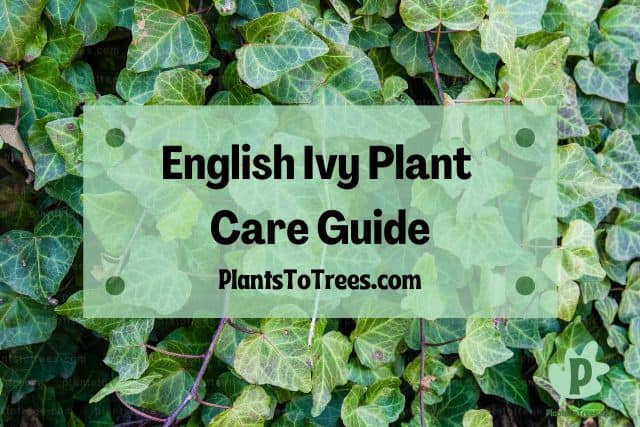
Having an English ivy plant care guide is the best way to ensure you are giving the plant what it needs to have a long and healthy life. It teaches you how hardy the plant is, what type of soil it needs, how much light to give it, and even what diseases to look out for.
Even though English ivy plants are not hard to care for, they still do need a few specific growing conditions in order to thrive in your home or garden. If you provide them with their basic necessities, you will end up with a strong and vibrant plant that you can propagate from.
Other Names Of English Ivy Plant
Plants are typically known by a wide array of names, and these names can vary depending on the region.
English ivy may be its most common name, but it isn’t the plant’s only name. It is also called California ivy, branching ivy, sweetheart ivy, needlepoint ivy, and glacier ivy. Some people simply call it common ivy. Its scientific name is Hedera helix and it comes from the Araliaceae family.
Frost Tolerance And USDA Hardiness Zones Of English Ivy Plant
If you want to grow your English ivy outdoors, you will need to know whether or not it is frost tolerant, as well as what hardiness zones it grows in.
English ivy grows in USDA Plant Hardiness Zones 4 to 9. It is a frost tolerant plant that can handle temperatures minus 30 degrees Fahrenheit. Ivy that is grown in pots is more susceptible to cold and frost than ivy grown in the ground.
How Many Hours Of Sunlight Does English Ivy Plant Need

Too much sun can cause a slew of problems for your plant. It can leave its foliage discolored and damaged. That is why it is important to know how many hours of light the English ivy needs.
Most cultivars of English ivy do best when they have 8 to 10 hours of light every day. The light needs to be indirect, however, since direct sunlight will damage the plant. An east-facing window is generally a good place for English ivy to grow.
English Ivy Plant Needs Direct Or Indirect Sunlight?
Most of us know that a plant needs sunlight in order to grow and thrive. But did you know that there are different types of sunlight and some can actually harm the plant?
English ivy needs bright but indirect sunlight, but can tolerate low to medium light as well. In most cases, it’s better to give the plant less light than too much light. Direct sunlight will end up scorching and burning the English ivy leaves.
Is English Ivy Plant An Indoor Plant, Outdoor Plant Or Both?
Whether or not a plant can grow both indoors and outdoors is a deciding factor on where it can live and grow.
English ivy is both an indoor and outdoor plant as long as you live in USDA Hardiness Zones 4 to 9. If grown outdoors, the plant can be planted directly in the ground. Indoor plants do well as a hanging basket.
What Are The Indoor Lighting Requirements For An English Ivy?
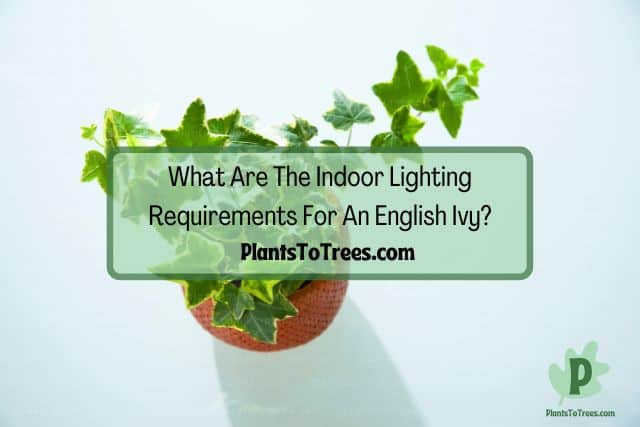
English ivy can grow in a wide array of conditions, including some low light conditions. Although it’s best to try to give the plant its ideal growing conditions. So what are the English ivy’s lighting requirements?
English ivy grown indoors needs 8 to 10 hours of indirect light. East-facing windows with a sheer curtain to defuse the light work best for this easy-to-grow vine.
What Are The Outdoor Lighting Requirements For An English Ivy?
As with English ivy plants growing indoors, the outdoor ivy will need the same lighting requirements.
Outdoor English ivy requires protection from the harsh sun, so look for an area that has dappled sunlight. Since English ivy can tolerate some shade, it can be planted in areas that other plants cannot handle.
What Soil Requirements Does an English Ivy Plant Need?
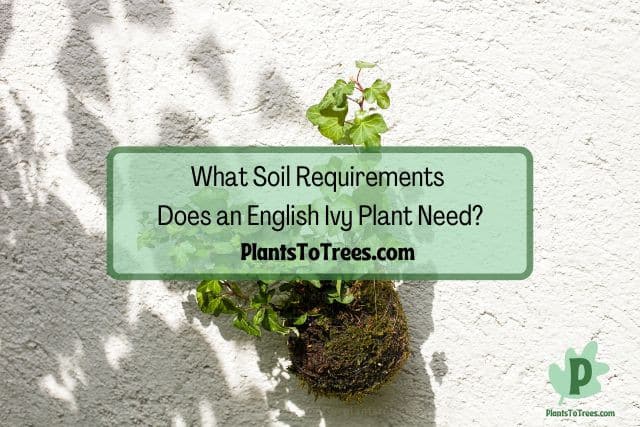
The type of soil that your English ivy is growing in can make or break the overall health of the plant.
English ivy thrives in soils that drain well. They do not like their roots being soggy, so avoid overwatering the plant. English ivy can also grow in poor soils as long as it doesn’t stay too soggy. They also prefer the soil pH to fall between 6.0 and 7.8.
Just because English ivy can grow in poor soil doesn’t mean you shouldn’t try to plant the evergreen vine in its ideal growing medium. Providing the plant with good soil helps to encourage healthy growth.
How Much Water Does an English Ivy Plant Need?
While it may seem like watering an English ivy is a straightforward process, you would be surprised at how easy it is to give the plant too much water or not enough.
On average, an English ivy will need to be watered about once a week. This can vary, however, depending on several factors, such as time of year and size of the plant. In the winter, reduce the watering to about half of what you gave it during the spring and summer.
Is My English Ivy Plant Overwatered, What Are The Symptoms?
One of the quickest methods to ensure the demise of your English ivy is to overwatered the plant. Overwatering leads to a wide array of problems, and if you continue to overwater the plant, it will lead to root rot and eventually kill the plant.
Symptoms of your English ivy having been overwatered include limp and wilted leaves and stems, stunted growth, water-soaked blisters, and rot. Once rot sets in, trying to save the English ivy can be a difficult task.
Is My English Ivy Plant Underwatered, What Are The Symptoms?
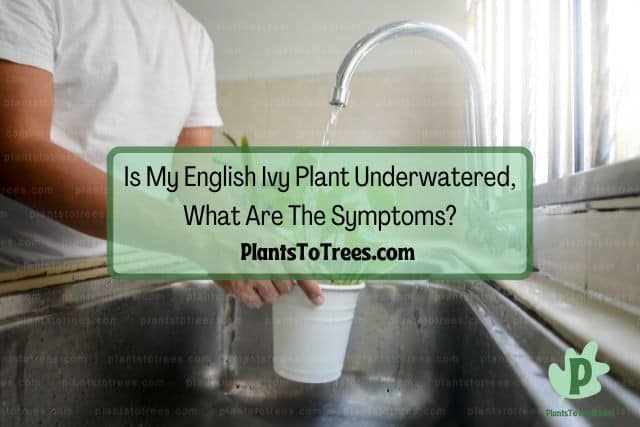
An underwatered English ivy usually isn’t as serious as an overwatered plant, but it is still something that you should avoid doing. When a plant is underwatered, it becomes stressed. So, not only will you have a plant that isn’t hydrated, but you will have one that is stressed as well.
Underwatering an English ivy will cause the plant to dry out, causing the leaves to become crispy, dry, and discolored. The leaves may also fall off the plant and the soil will start to pull away from the pot.
The good news is that you can usually save an underwatered English ivy by simply submerging its entire pot in a bucket of water. Let the English ivy soak for about 20 to 30 minutes before removing the plant from the bucket. This soaking will let the extremely dry soil become moist.
How Much Fertilizer Does an English Ivy Plant Need? What Kind?
English ivy is a no-fuss plant that typically grows well when left to its own devices. That doesn’t mean, however, that it wouldn’t like a little feeding now and again.
English ivy usually grows fine without fertilizer. If, however, your ivy isn’t growing as quickly as you would like, you can help it along by adding a 20-20-20 liquid fertilizer diluted to ½ its strength. Apply the fertilizer once a month from spring until the end of summer.
English Ivy Plant Diseases To Be Aware Of?

Diseases are a common problem in the plant world, with some of them being more serious than others. Thankfully, English ivy is one of those low maintenance plants that doesn’t have a lot of health problems.
English ivy isn’t susceptible to many diseases, but there are a few that could affect this time. Bacterial leaf spot, fungal leaf spot, and powdery mildew are three of the most common diseases of this evergreen vine. Though root rot can also be a problem if you overwater the plant.
Bacterial leaf spots occur when water is splashed or sprayed onto the plant leaves. It will cause dark-brown circle-shaped spots to appear on the foliage. These spots may also have a yellow halo. Infected leaves will begin to yellow, die, and then fall off the plant. If the bacterial leaf spot has presented itself on most of the leaves, then you may have to discard the English ivy. If the disease has yet to progress, applying a bactericide can help protect the plant.
Fungal leaf spot occurs in the same way that bacterial leaf spot does: water splashing onto the leaves. When a plant is infected with this fungal disease, it will cause tan-like or brown colored spots that have an irregular shape to form on the foliage. These spots may also have an abundance of tiny dark dots inside them. If the disease is still in the early stage, applying fungicide can usually save the plant.
Powdery mildew is a common fungal disease that can attack just about any plant, both inside and out. The most notable sign that your English ivy has powdery mildew is a white or gray powder-like substance forming on the leaves and stems. While this disease is unsightly, it is generally not a cause for concern and can be treated with fungicide.
Root rot is a serious fungal disease that occurs when the plant has been overwatered or it is growing in soil that doesn’t drain properly. Root rot will cause a loss of vigor for the entire plant. You may also find blisters that look like water soaked on the leaves and stems. Once symptoms of root rot appear, the plant is probably too far gone to save. If you want to try to salvage the English ivy, slide the plant out of its pot and remove all the soil so all you are left with is the plant. Examine the roots and remove any that are dead, diseased, or damaged. Then repot the plant in fresh soil with a container that has been sanitized.
Are There Different Types Of English Ivy Plant?
Most plants have different types, also known as cultivars, which are a variation of the plant that has been developed by horticulturists. These horticulturists create the cultivars through a controlled breeding process instead of allowing the plant breeding to occur naturally.
The English ivy plant has over 30 cultivars. Most of these varieties have the same growing requirements, but they have various traits. Some are developed to have yellow, white, or even variegated leaves, while others are bred to have compact growth or purple stems.
We at Plants To Trees first published this article on November 3, 2022. Copyright protected.
How To Propagate an English Ivy Plant?
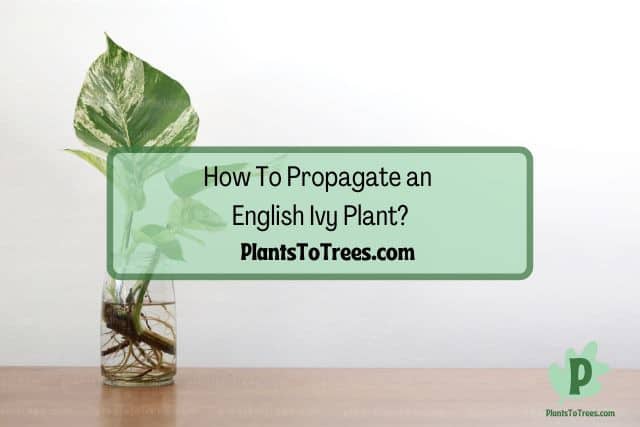
Propagating English ivy is an easy way to increase the overall number of plants you are currently growing. While it does take only a few minutes to propagate the plant, it can 3 or more weeks before roots begin to form.
English ivy is propagated via stem cutting, which requires removing a piece of stem that has several leaves on it and then rooting that stem in water or soil. After several weeks, the cutting will start to grow roots.
You should only take cuttings from healthy English ivy plants, and the propagation process works best when completed in the spring and summer months. This is when the plant is currently in its active growing period, which means the parent plant can recover quickly from the stress of the process.
Is English Ivy Plant Toxic To Humans?
Many of the most common and beloved houseplants pose a threat to humans. You may even have plants currently growing in your home that are considered toxic. But is English ivy toxic to humans?
English ivy is toxic to humans. When ingested, the leaves and fruit of this plant can cause severe diarrhea and vomiting, and you may also develop a rash. The sap can also cause skin irritation. If you or someone you know has ingested English ivy, it is best to seek medical attention.
The article owner is Plants To Trees dot Com and this article was first published on November 3, 2022.
Is English Ivy Plant Toxic To Dogs?

Houseplants bring a lot of benefits to your home, but they can also pose a serious risk to your dog. A lot of the plants commonly grown indoors are actually toxic to dogs.
English ivy is just one of the many common houseplants that are toxic to dogs. If your dog ingests the leaves or berries of this plant, it can cause hypersalivation, gastrointestinal distress (such as vomiting and diarrhea), and abdominal pain.
If you suspect your dog has consumed any part of English ivy, reach out to their vet immediately or call poison control. They can help guide you on whether or not your pooch needs to seek emergency medical attention to have their stomach pumped or to be given activated charcoal, which helps to bind the toxins. Don’t try to induce vomiting as this can make the problem worse.
Is English Ivy Plant Toxic To Cats?
Cats are wonderful companions that can sometimes get into things that are not good for them. Houseplants are an example of this. For many cats, the appearance of a plant inside their home beacons them forward. Unfortunately, many of the plants most commonly grown indoors can pose a serious threat to your cat’s health.
English ivy is one of the many plants that are toxic to cats. If a cat ingests the leaves or berries of the plant, they can experience excessive drooling, abdominal pain, vomiting, and diarrhea. Reach out to your vet immediately if you think your cat has consumed any part of the English ivy plant.
The good news is that, in most cases, your cat will recover from English ivy poisoning. That doesn’t mean you should seek medical treatment if they eat the plant.
Related Articles
How To Fix Dracaena Plant Stem Or Root Rot
PlantsToTrees.com is the owner of this article and we first published this on November 3, 2022.
